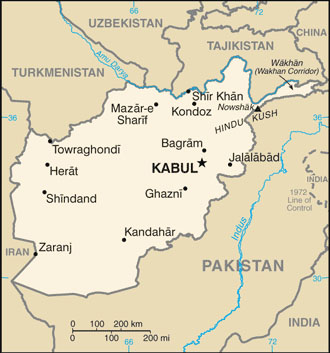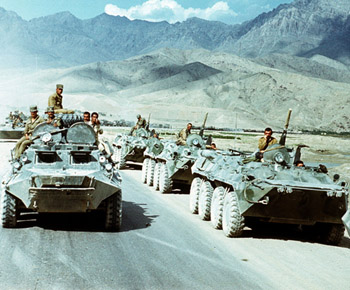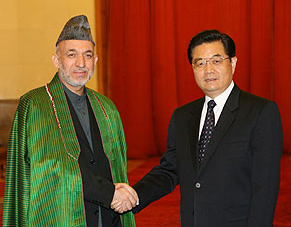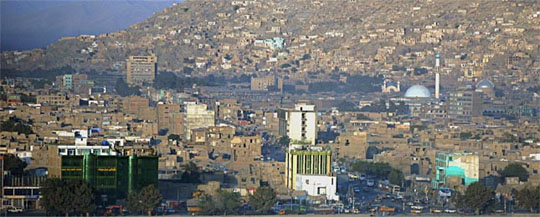Afghanistan Now Part of China’s Central Asian Push
This is the fifteenth in a series of articles that looks at China’s borders. As China has grown in the last 30 years, so have the often complicated relationships it has with its many varied neighbors. In this article, we take a look at Afghanistan.
By Andy Scott
Sept. 23 – At one time, Afghanistan was center for some of the world’s most important civilization. The arts and sciences thrived, cultivation and advanced farming techniques turned the plains around Kabul into a great bread basket. Then in 1219, the Mongols came. They left a devastating path of destruction that that the country has never quite recovered from. Since then, the land has become one that has inevitably been in between, acting as a bit player in The Great Game, and a staring role in the collapse of the Soviet Union. Following the terrorist attacks on the United States on September 11, Afghanistan once again played host to world powers. Situated as it is in Asia, it is something that shouldn’t have come as a surprise.
 Afghanistan sits at the heart of Asia, dividing and linking the Middle East to South Asia and Central Asia. It lies at the westernmost part of the Himalayas. Afghanistan’s land corridor represents, as Stephan Tanner points out in his military history of the country, an invasion route that has borne witness to armies of Persians, Greeks, Mauryans, Huns, Mongols, Moghuls, British, Soviets and Americans. It borders Pakistan, Iran, Turkmenistan, Uzbekistan, Tajikistan, and for a mere 76 kilometers, China.
Afghanistan sits at the heart of Asia, dividing and linking the Middle East to South Asia and Central Asia. It lies at the westernmost part of the Himalayas. Afghanistan’s land corridor represents, as Stephan Tanner points out in his military history of the country, an invasion route that has borne witness to armies of Persians, Greeks, Mauryans, Huns, Mongols, Moghuls, British, Soviets and Americans. It borders Pakistan, Iran, Turkmenistan, Uzbekistan, Tajikistan, and for a mere 76 kilometers, China.
“An unlucky country”
Ahmad Shah Durrani created the Durrani Empire in 1747, and by 1751 had conquered the entire present-day Afghanistan, Pakistan, Khosaran and Kohistan provinces of Iran, along with Delhi in India. Durrani established his capital in Kandahar, where his tomb, a pilgrimage site for many, remains to this day. Following his reign, the capital was shifted to Kabul and much of Afghanistan’s territories ceded to the British in the 19th century. After becoming a buffer state in The Great Game played between Britain and Russia, Afghanistan regained full independence from the United Kingdom on August 19, 1919, following the third Anglo-Afghan war.
 After relative peace and prosperity in the first half of the 20th century, Afghanistan has suffered under a continuous and brutal civil war. Beginning with Abdul Qadir’s Soviet-backed coup of the ruling government of Mohammad Daud in 1978 (who himself had come to power in a coup of King Mahammead Zahir Shah), and followed closely by the Soviet invasion in 1979, the country has suffered under a brutally continuous civil war. Following the Soviet pull out in 1989, Afghanistan once again lost any chance for peace as regional factions squared off. With the emergence of the Taliban, the country was virtually cut off from the modern world, while war continued as the anti-Taliban forces of Ahmed Shah Massoud and the Northern Alliance retreated to the mountains of Northern Afghanistan and the Taliban took control of country. The U.S-led invasion that toppled the Taliban from power failed to bring peace to the country, and while NATO troops assisted the government of current-President Hamid Karzai gain control of the major urban centers and billions of dollars have been provided by the international community for reconstruction, the Taliban has remained in concentrated pockets and the fighting continues.
After relative peace and prosperity in the first half of the 20th century, Afghanistan has suffered under a continuous and brutal civil war. Beginning with Abdul Qadir’s Soviet-backed coup of the ruling government of Mohammad Daud in 1978 (who himself had come to power in a coup of King Mahammead Zahir Shah), and followed closely by the Soviet invasion in 1979, the country has suffered under a brutally continuous civil war. Following the Soviet pull out in 1989, Afghanistan once again lost any chance for peace as regional factions squared off. With the emergence of the Taliban, the country was virtually cut off from the modern world, while war continued as the anti-Taliban forces of Ahmed Shah Massoud and the Northern Alliance retreated to the mountains of Northern Afghanistan and the Taliban took control of country. The U.S-led invasion that toppled the Taliban from power failed to bring peace to the country, and while NATO troops assisted the government of current-President Hamid Karzai gain control of the major urban centers and billions of dollars have been provided by the international community for reconstruction, the Taliban has remained in concentrated pockets and the fighting continues.
Cause for concern
China watched the rise of the Taliban with apprehension, the militant Islamic ideology that the regime practiced was a cause for concern. China’s vast frontier province of Xinjiang, inhabited by the Uyghur Muslim minority with traditional ethnic ties to Afghanistan and the other Central Asian Republics, is a security concern for Beijing. Ethic unrest, which flared up again recently in parts of Xinjiang, represents an internal pressure that Beijing remains wary of. The resurgence of the Taliban in parts of Afghanistan and the continued virtual statelessness of many parts of the country are a concern for Beijing. China is interested in a stable, moderate state, open to Chinese investment and, perhaps most importantly, also free of Western military presence. However, if current trends continue, it could be years before NATO forces are out of Afghanistan. China meanwhile, is keen to keep the simmering tensions in Xinjiang under control and will likely remain non-committal towards Western forces in the region while the Taliban is still a significant problem.
Commercial and strategic interests
 Afghanistan was initially overlooked in Beijing’s hop-scotch shopping trip through Central Asia in the late 1990s. Having played an important role in the Afghan civil war and a key source of small arms to the Mujahideen during the war with the Soviets, China invested in Southeast Asia, Siberia and other Central Asian states. That all changed in 2006 when the State-owned China Metallurgical group invested a staggering US$3.5 billion in Afghanistan’s Aynak copper field. The largest foreign direct investment the country’s history, involves not only mining, but according to a report from the Central Asia-Caucasus Institute, also the construction of a US$500 million electrical plant and a railways from Tajikistan to Pakistan to support exploration.
Afghanistan was initially overlooked in Beijing’s hop-scotch shopping trip through Central Asia in the late 1990s. Having played an important role in the Afghan civil war and a key source of small arms to the Mujahideen during the war with the Soviets, China invested in Southeast Asia, Siberia and other Central Asian states. That all changed in 2006 when the State-owned China Metallurgical group invested a staggering US$3.5 billion in Afghanistan’s Aynak copper field. The largest foreign direct investment the country’s history, involves not only mining, but according to a report from the Central Asia-Caucasus Institute, also the construction of a US$500 million electrical plant and a railways from Tajikistan to Pakistan to support exploration.
The investment could only be the start of a new Sino-Afghan relationship. Afghanistan has large unexplored reserves of oil and natural gas in the northern part of the country. It also has large iron ore deposits between Heart and the Panjsher Valley as well as gold reserves in the province of Badakshan, Takhar and Ghazni.
As China demands increasing amounts of raw materials for its rapidly expanding economy, these reserves will become strategically important to Beijing. It is unlikely that other foreign investors will be able to outbid the Chinese when it comes to securing the rights to explorer these fields as Chinese State-owned companies have been quite active in the developing world, in many cases doubling the projects bids of their foreign rivals.
Afghanistan is also important for China because of its proximity to Pakistan. According the Jamestown Organization’s China Brief, Pakistan, China’s foremost ally in South Asia and instrumental in China’s emergence on the global scene, is constrained by its lack of geographic depth. Often touted as a strategic weakness in Pakistan’s confrontation with India, Pakistan’s military view a friendly Afghanistan gives them additional strategic depth, a major reason for Pakistan’s support of the Taliban. China also, like Czarist Russia, wants access to the India Ocean, and has invested heavily in the port of Gwadar on Pakistan’s Mekran Coast. The port will enable China to project its military presence into global petroleum shipping routes and the oil states of the Middle East. Should the port be connected to the oil and gas fields of Central Asia and road and rail links improved, it would become economically as well as strategically important.
This is the fifteenth in a series that focuses on China’s borders. The complete series can be found here.
For more commentary on the emerging nations of Asia, please visit out sister website, www.2point6billion.com.
- Previous Article CIC in Talks to Buy 49% of Morgan Stanley
- Next Article New Issue of India Briefing Now Available










